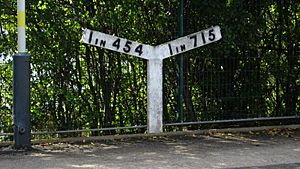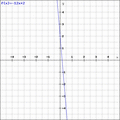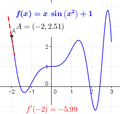Slope facts for kids
The word slope is used to describe how much something goes up or down. Imagine you're walking on a hill. If the hill goes up, it has an upward slope. If it goes down, it has a downward slope. Slope tells us how steep something is.
Slope can mean a few different things:
- It can be an area of ground that goes evenly up or down, like a ski slope.
- It can describe how much a surface tilts, either upward or downward. For example, a roof has a slope so rain can run off.
- In mathematics, slope is a way to measure how steep a line is on a graph. It tells us how much the line goes up or down for every step it takes sideways.
Contents
What is Slope?
Slope is a measure of steepness. Think about a ramp. A very steep ramp has a big slope, and it's hard to walk up. A gentle ramp has a small slope, and it's much easier to climb.
Slope in Everyday Life
We see slopes everywhere around us!
- Roads and Paths: Roads often have slopes to help cars go up and down hills. You might see signs that say "Steep Grade" to warn drivers about a big slope.
- Roofs: The roof of a house is sloped so that rain and snow can slide off easily, preventing water from collecting and damaging the house.
- Playgrounds: Slides on a playground are a fun example of a slope. The steeper the slide, the faster you go down!
- Ski Slopes: Ski resorts have different slopes for different skill levels. Green slopes are gentle, blue slopes are a bit steeper, and black diamond slopes are very steep and challenging.
Slope in Mathematics
In math, especially when you're working with graphs, slope has a very specific meaning. It helps us understand how a line changes.
Measuring Slope on a Graph
When we talk about the slope of a line on a graph, we are looking at how much the line goes up or down (the "rise") compared to how much it goes across (the "run").
- Rise: This is the vertical change between two points on a line. If you move from one point to another, how much did you go up or down?
- Run: This is the horizontal change between the same two points. How much did you go left or right?
The formula for slope is: Slope = Rise / Run
Let's say you have two points on a line. The first point is (x1, y1) and the second point is (x2, y2).
- The rise is the difference in the y-coordinates: y2 - y1
- The run is the difference in the x-coordinates: x2 - x1
So, the mathematical formula for slope (often called 'm') is: m = (y2 - y1) / (x2 - x1)
Positive, Negative, and Zero Slope
- Positive Slope: If a line goes uphill from left to right, it has a positive slope. This means both the rise and the run are positive (or both negative, which still results in a positive slope).
- Negative Slope: If a line goes downhill from left to right, it has a negative slope. This means one of the changes (rise or run) is positive and the other is negative.
- Zero Slope: A perfectly flat, horizontal line has a zero slope. This is because there is no "rise" (the y-value doesn't change).
- Undefined Slope: A perfectly straight up-and-down, vertical line has an undefined slope. This is because there is no "run" (the x-value doesn't change), and you can't divide by zero in math.
Slope and Steepness
The larger the number (whether positive or negative) for the slope, the steeper the line is.
- A slope of 1 is less steep than a slope of 5.
- A slope of -1 is less steep than a slope of -5 (because -5 means it's going downhill much faster).
Understanding slope is very important in many areas of math and science, like physics and engineering, because it helps us describe how things change and move.
Images for kids
-
A 1371-meter distance of a railroad with a 20‰ slope. Czech Republic
See also
 In Spanish: Pendiente (matemática) para niños
In Spanish: Pendiente (matemática) para niños






